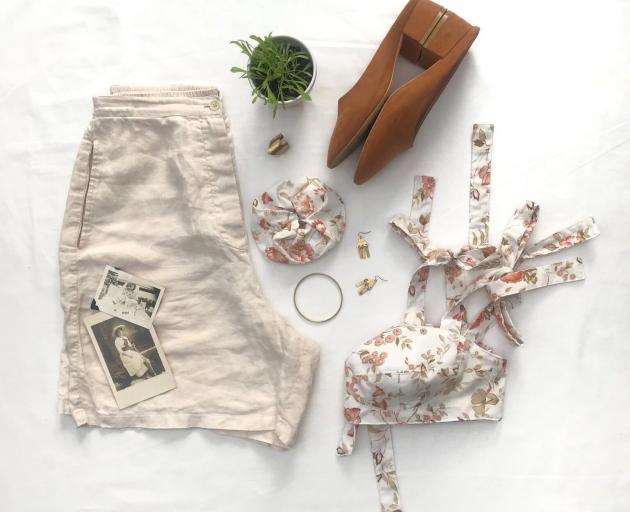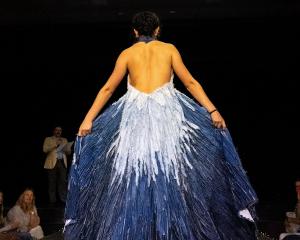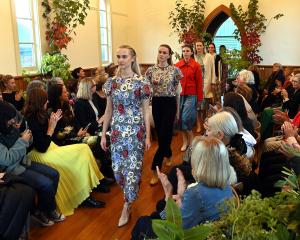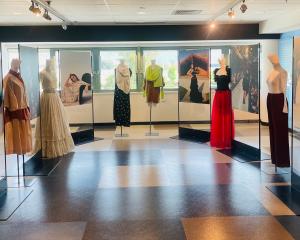
Brittany Pooley looks into zero-waste fashion, where the little steps count.
Zero waste is a philosophy that asks us to reconsider the life-cycle of our products so they can be reused.
The movement encourages consumers to evaluate purchases so as to reject waste from their everyday lives.
The overarching goal of a zero-waste lifestyle is to help contribute to the elimination of harmful waste to our land, water and air which threatens our health, as well as that of animals and plants.
Zero waste promotes living a more simple life and takes a stance against needless, consumerism-driven waste; it is about rethinking the everyday.
Textile waste and pollution is a global and growing concern for fashion.
Today I consider zero-waste approaches to pre-consumer and post-consumer waste in the fashion industry and chat with local designer Eilish Lie-Olesen about the little steps she takes towards zero-waste with her label, Eilish and Co.
Pre-consumer zero waste

To lessen textiles waste, we must consider the design and manufacturing processes that take place before purchasing fashion products.
Pre-consumer zero waste involves the waste that occurs before the fashion product meets the consumer, including fabric offcuts created during the cutting process. It has two main approaches: Zero-waste fashion design, and zero-waste manufacture.
In the process of zero-waste fashion design, the designer creates a garment with a focus on pattern-cutting. This differs from typical garment production.
Traditionally, designers will have a drawn or draped design of the final garment from which a pattern is made. Using this pattern, a lay plan is created to figure out how to best arrange the pattern pieces to fit the fabric which reduces but doesn't eliminate waste. The offcuts of the fabric are then put aside for zero-waste manufacture, or discarded as textile waste, contributing to the problem of textile pollution in the industry.
In contrast, zero-waste fashion designers create a pattern that fits within the space of the fabric they're using, which ultimately determines the design.
Through this process, there are no offcuts as the designer has used all the fabric, therefore there is zero waste involved.
Zero-waste manufacture focuses on eliminating textile waste without modifying garment patterns. This is approached in many ways.
Textile practices such as knitting and weaving can incorporate zero-waste manufacture through the making of fabric.
Indian designer Siddhartha Upadhyaya created ''DPOL'', or ''Direct Pattern on Loom,'' an innovative digital technology for weaving fabric in the shape of garment pieces with finished edges. As nothing is cut, these practices ultimately eliminate all waste.
Similarly Auckland-based contemporary weaver Christopher Duncan, who weaves specific shapes that then come together to create a garment, removing the cutting process.
Zero-waste manufacture is also achieved through whole garment knitting. This is knitwear that is produced on a knitting machine, creating one entire three dimensional piece.
More generally, zero-waste manufacture is achieved by reusing the offcuts of fabric used for garments to create other products.
Post-consumer zero waste
Post-consumer waste is the waste produced by the end consumer. It occurs at the end of a garment's life when it typically ends up in landfill.
Post-consumer zero waste is a design approach that utilises textile waste to produce new fashion products. American designer, ''Zero-waste Daniel'', is a young, emerging designer making waves in the industry. With innovative pattern making techniques, tiled mosaic designs and specialty textiles, Daniel Silverstein is a pioneer in zero-waste fashion, taking literal textile waste and creating fresh, contemporary fashion products.
Recovering waste that is produced post-consumer can occur through the reusing, repurposing, upcycling and reselling of fashion products.
Basically, it is important to carry on the life of a garment as long as possible before recycling or discarding. A garment's life should be long and purposeful.
To prolong the life of your garments, take care and correctly launder. Make good use of your existing closet, mending and altering pieces when needed.
If you no longer use a product, consider where it could go next: host a clothes swap, sell locally or online, donate, or gift. I
When you feel your garment can no longer be of use, find a suitable new purpose through repurposing, or add value through upcycling. Buy second-hand or vintage to continue the story of other people's clothing.

A little step is bigger than none
Local fashion designer Eilish Lie-Olesen incorporates zero waste into her work in order to take a more holistic approach to fashion.
Her Dunedin-based label, Eilish & Co, values the individuality of women, and is driven by both inclusivity of the diversity of women and ethical practice. Eilish and Co is one of the few New Zealand-based labels leading the way for inclusivity in the industry.
Lie-Olesen is torn between a love of fashion, and an awareness of the ethical concerns surrounding the industry. Ultimately, she chose for these ethical concerns to drive her practice, rather than detour it, selling a balance of new designs, zero-waste accessories and vintage clothing.
''Definitely a bit of guilt for being part of such a toxic industry. I have quite a love/hate relationship with fashion - I love to create garments that are inclusive and help people to express who they are but I really dislike how wasteful and unethical the industry can be.''
While she practices elements of zero-waste manufacture, Lie-Olesen is interested in upskilling to incorporate zero-waste design into her practice. She sees zero waste as a journey, taking small steps towards more ethical practices.
''I wanted to reduce my waste from the cutting process and, although I'm not the flashiest at pattern-making, making little scrunchies and even a couple of bucket hats from the scraps was a good way to cut down and becoming completely zero-waste is definitely a goal for future - small steps, you know? A little step is bigger than none,'' Lie-Olesen says.

Alongside her own designs, Lie-Olesen sells a curation of vintage pieces that align with her label's aesthetic.
''I've always had a soft spot for vintage, especially the thrill of the hunt aspect of it, and how you can give something a new lease on life - especially the really old, heirloom pieces.''
In attempt to recover textiles waste, Lie-Olesen values and shares the stories and quality that vintage fashion holds.
''They have such a story to tell and sometimes I wish the garments could talk because a couple of the ones in my shop have seen the turn of the 20th century, survived the wars, and been passed down generations. Not to mention the quality and attention to detail; it's honestly something else and very rare to find in the age of fast fashion.''
Zero-waste design and manufacture at times requires more thought, conversation and skill than conventional fashion design and manufacturing processes.
It is because of this that the small steps taken by our both our New Zealand fashion designers and consumers are well worth supporting and celebrating.












